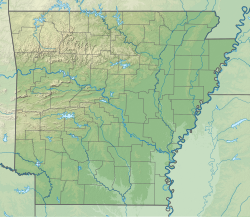Arkansas Post, Arkansas | |
|---|---|
 Bayous around Arkansas Post | |
| Coordinates: 34°01′25″N91°20′37″W / 34.02361°N 91.34361°W | |
| Country | |
| State | |
| County | Arkansas |
| Township | Arkansas |
| Founded | December 27, 1831 |
| Named after | Arkansas Post |
| Elevation | 177 ft (54 m) |
| Time zone | UTC−06:00 (CST) |
| • Summer (DST) | UTC−05:00 (CDT) |
| GNIS feature ID | 66948 [1] |
| Highways | |
| Major airport | Clinton National Airport (LIT) |
Arkansas Post is an unincorporated community located along the north side of the Arkansas River in Arkansas County, Arkansas. [1] It is home to the Arkansas Post National Memorial.

